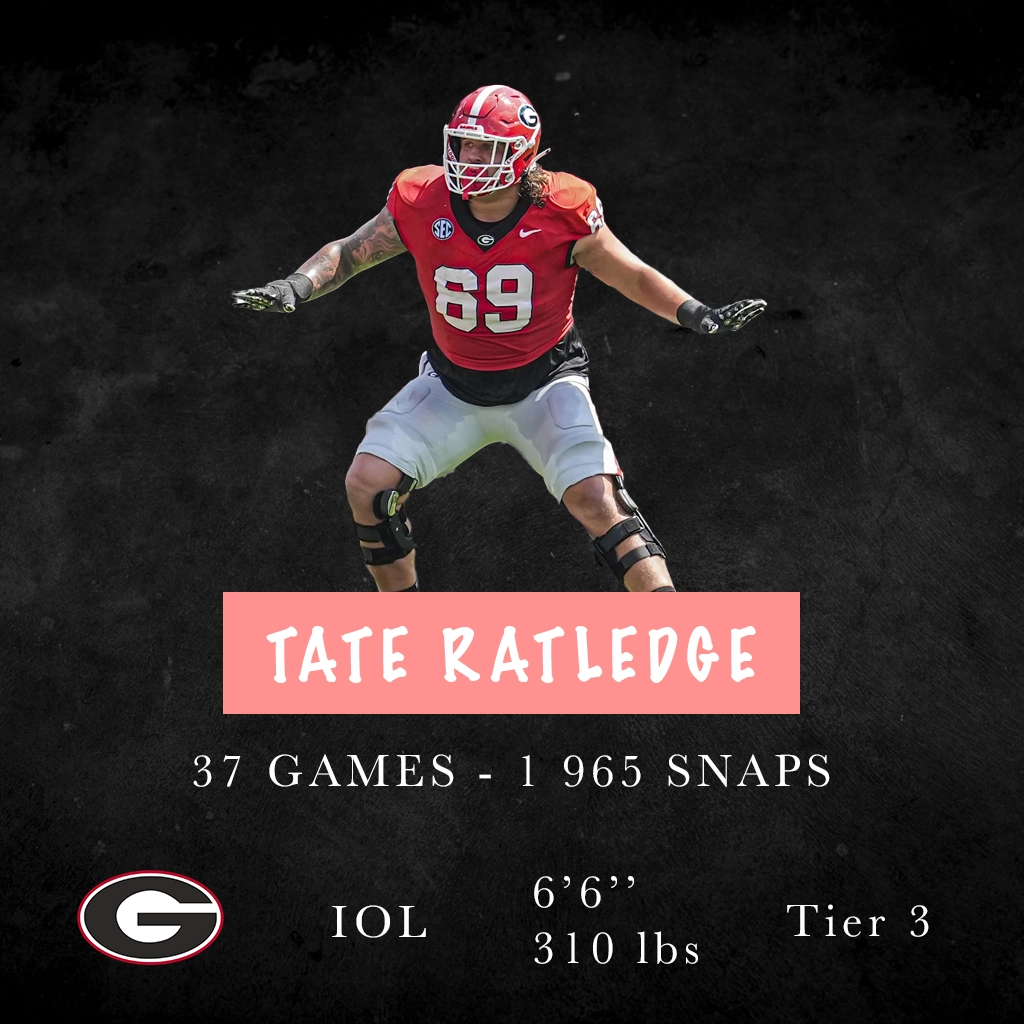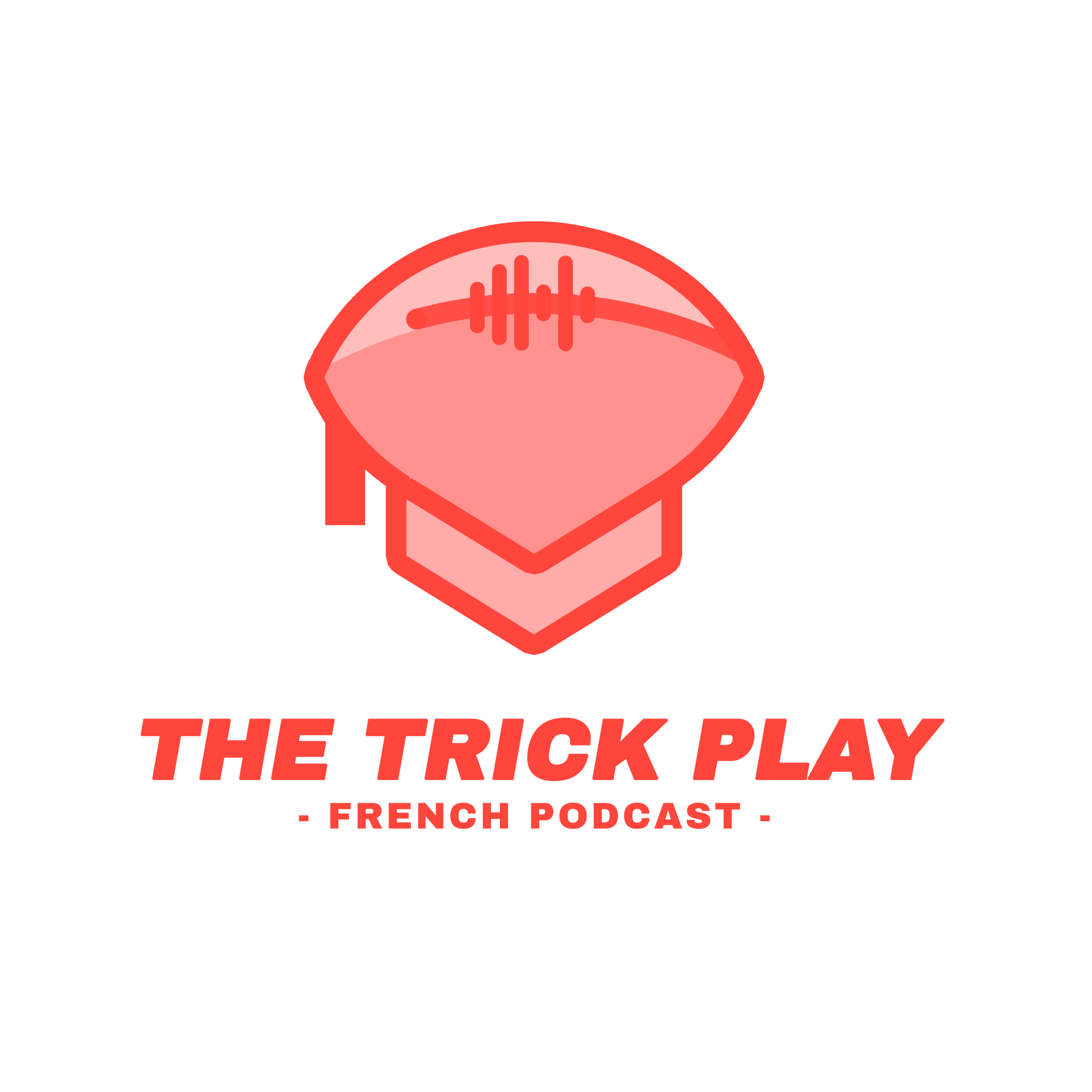Tate Ratledge, IOL, Georgia (Senior)

Rayane M
The 2025 NFL Draft is fast approaching, and despite an initial impression that this year's class might lack talent, The Trick Play team has once again delved into the tapes to bring you scouting reports on the players who will soon wear the jerseys of your favorite franchises.
From Quarterback to Safety, including the trenches where Offensive Linemen and Defensive Linemen engage in a relentless battle, Rayane and Valentin will walk you through the new faces of this 2025 draft class while everyone is excited about the coming NFL Draft
Strengths :
- Athleticism
- Size
- Hips movement
- Good reading
- Floor
Weaknesses :
- Footwork
- Forward imbalance
- Leverage
- Potential
IOL Tate Ratledge
— Rayane M (@RayaneScout) April 12, 2025
A rather simple choice to make if your team is looking for a solid IOL capable of grafting onto your OL Day 1.
While Tate obviously has some progress to make, his floor will be a point that could enable him to be selected quickly.
Tier 3🛠️ pic.twitter.com/IIIQMdOVNj
TTProfil
If I didn't have to wait to see him at the Combine to understand that Tate is a mobile, explosive and powerful player, his performance at this event, which is particularly closely watched by draft experts and soccer fans, only confirmed the flashes shown on the tapes.
While this doesn't necessarily make him a good player, as it does for many others, it does give NFL teams an important indication of his ability to match the athletic prowess of big-league players.
At 6’6 and 308lbs, Tate has a frame that’s closer to a Tackle than a Guard, which will naturally appeal to GMs who love big-bodied players. While I don’t think his wingspan was the initial reason for placing him at the Guard position, it’s clear that it won’t allow him to be tested at Tackle in the pros.
He's really good at this, and it helps him a lot, especially in run situations, to open up real lanes for his ball carriers when he executes it well. Whether it's on power runs or zone plays, it's not uncommon to see Tate try to seal the defender with his hip to really create a highway for his runner, and that's something I appreciate about him.
That said, Ratledge could become a much better blocker on the ground game with a few improvements we'll see later.
Small downside though, I noticed that he can sometimes overdo it on this specific point. In his effort to do things right, Tate sometimes overcommits by staying too long with his primary threat, which puts him behind when it comes to picking up the new threat on stunt situations. As I said, it comes from a good place since Tate is trying to help his teammate as much as possible, but in doing so, he really puts himself in a tough spot.
His play translates well to what is done in the NFL, and he should, without too much trouble, be able to secure a spot on an offensive line after the draft. I would be truly surprised to see Tate need an adjustment period, and while I can't promise he'll shine in his first pro game, I have no doubt that he'll be able to do the job right away.
Among the many footwork issues with Ratledge, one of the most common is his legs constantly stopping, whether at impact or even when the block is engaged, his legs can come to a halt. This is something that can be observed both in run situations and in pass protection, and it really works against him. In fact, it's quite simple—most of his reps are compromised because of this, and the lack of activity in his lower body also affects other aspects of his play. It's such a shame.
Another classic issue with his footwork is his base narrowing. Yes, because while Tate often has his legs at a standstill, he is still capable of having some good reps where his legs are moving, and he shows that he can drive his opponents. However, naturally, the footwork issue arises when he narrows his base, which makes him vulnerable to being off-balanced by any sudden change of direction, causing him to lose a block that was initially secured. So, we have another area to work on with his footwork, but it's not the last one.
For lighter offensive linemen, it's a different story since they can't rely on their weight to stop the defender cold. Instead, they need to use various techniques to gradually stop or slow down the defender before they can properly anchor into the ground. For these linemen, the techniques used vary depending on their strengths, but we might see a big, explosive punch that halts the defender and allows the lineman to anchor, or they might make direct contact with the defender and then take several quick, explosive steps to slow the defender down until they come to a complete stop. Another technique is the Power hop, which is widely used in the NFL but less common in college football. This involves using the arms to reduce the initial impact of the defender, followed by small backward hops to slow the defender down in fits and starts. It's harder, but once it's mastered, it's very effective.
Now that we've covered that, let's go back to what concerns us, Tate's case. He most often defaults to the second method, trying to take multiple steps to slow down the defender before anchoring. However, since his footwork is slow and uneven, his "recovery speed" on his anchor isn't good enough. So, even when Tate doesn't lose the rep and successfully blocks his player, it's not uncommon to see the QB compressed in the pocket because Tate has been pushed back by 3 or 4 yards, thus almost pinning the QB to him. This forces the QB to make an extra effort to move properly in the pocket, or sometimes it even causes him to panic, thinking the pocket is collapsing, which leads to the QB scrambling or rushing his decisions, often resulting in poor choices.
Once again, Footwork has room for improvement, which could enable Tate to make a real leap forward in terms of quality.
This point is less important because it happens less often than the previous ones, but it's still present and can be extremely dangerous for the QB's health, and once again is the result of a Foowork which is therefore bad overall and represents, in my opinion, the number 1 area of work for Tate Ratledge.
Exactly, since his legs aren’t active, as soon as Tate starts relying too much on his opponent or places too much weight forward, it only takes his opponent to evade him or change direction explosively, and Tate loses his balance. Since his legs are completely inactive, Ratledge can’t recover from his delay and ends up getting beaten. Most of the time, he can’t even limit the damage because his lower body is completely out of sync.
While working on his Footwork will enable him to make progress in this area, Tate could try to stay a little more in control and place himself less off-balance to avoid finding himself in these situations.
I’ve said it so many times, and I’ll keep repeating it, but it’s not by lowering your head or chest that a player can get any leverage. It’s by lowering their center of gravity and putting more weight on their legs, which can then be extended during the play to create that leverage effect, allowing them to lift the defender and put them in a position of imbalance. Yet, players and coaches know this, but it’s easier said than done. And once again, with Tate’s footwork being what it is, you can guess that his legs aren’t doing the work, and Tate naturally lowers his upper body because he’s developed this bad habit.
Once again, if he improves his footwork, it’s very likely that we’ll see him progress in his leverage ability as well. The same logic applies here. Just like the previous point, if Tate can improve his leverage ability, it should help enhance his footwork.
There is also a scenario where Tate simply isn't able to progress beyond this point and is therefore limited to a solid starter ceiling. In this case, he could have a good career, but what value should be placed on the player? That's a question everyone will have their own answer to, but it will depend on your team and its situation.
In any case, there will be a question mark over his ceiling when it comes to selecting him in the next draft.
This floor represents Tate Ratledge's strength in relation to other profiles that have similar athletic abilities but are more project-oriented.
That's the whole issue with him, with his Footwork being the main area for improvement, impacting on many aspects of his game. This is a real shame, given his athletic abilities, which should in principle have helped to make his Footwork his number one strength.
But then, what to do with Tate Ratledge? That will be up to the teams to judge. If some teams are looking primarily for immediate help, there's no doubt that Tate will be a prospect with great value despite questions about his potential. For teams that don’t need immediate help but are looking to grab a player with enormous potential to eventually replace a starter on the decline in a few seasons, Tate might hold only minimal value in their eyes.
